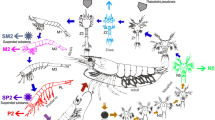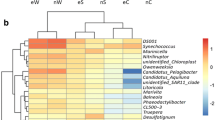Abstract
The gut microbiota of aquaculture species contributes to their food metabolism and regulates their health, which has been shown to vary during aquaculture progression of their hosts. However, limited research has examined the outcomes and mechanisms of these changes in the gut microbiota of hosts. Here, Kuruma shrimps from the beginning, middle, and late stages of aquaculture progression (about a time duration of 2 months between each stage) were collected and variations in the gut microbiota of Kuruma shrimp during the whole aquaculture process were examined. High-throughput sequencing demonstrated increases in the diversity and richness of the shrimp gut microbiota with aquaculture progression. In addition, the gut microbiota composition differed among cultural stages, with enrichment of Firmicutes, RF39, and Megamonas and a reduction in Proteobacteria in the mid-stage. Notably, only very few taxa were persistent in the shrimp gut microbiota during the whole aquaculture progression, while the number of taxa that specific to the end of aquaculture was high. Network analysis revealed increasing complexity of the shrimp gut microbiota during aquaculture progression. Moreover, the shrimp gut microbiota became significantly more stable towards the end of aquaculture. According to the results of neutral community model, contribution of stochastic processes for shaping the shrimp gut microbiota was elevated along the aquaculture progression. This study showed substantial variations in shrimp gut microbiota during aquaculture progression and explored the underlying mechanisms regulating these changes.





Similar content being viewed by others
Data Availability
The data that support the findings of this study will be made available when needed and on request.
References
Bastian M, Jacomy M (2009) Gephi: an open source software for exploring and manipulating networks. In: International AAAI Conference on Weblogs and Social Media: San Jose, CA, USA
Berg J, Brandt KK, Al-Soud WA, Holm PE, Hansen LH, Sørensen SJ, Nybroe O (2012) Selection for Cu-tolerant bacterial communities with altered composition, but unaltered richness, via long-term Cu exposure. Appl Environ Microbiol 78:7438–7446
Berry D, Widder S (2014) Deciphering microbial interactions and detecting keystone species with co-occurrence networks. Front Microbiol 5:219
Bokulich NA, Kaehler BD, Rideout JR, Dillon M, Bolyen E, Knight R, Huttley GA, Caporaso JG (2018) Optimizing taxonomic classification of marker-gene amplicon sequences with qiime 2’s q2-feature-classifier plugin. Microbiome 6:90
Bokulich NA, Subramanian S, Faith JJ, Gevers D, Gordon JI, Knight R, Mills DA, Caporaso JG (2013) Quality-filtering vastly improves diversity estimates from Illumina amplicon sequencing. Nat Methods 10:57–59
Burns AR, Stephens WZ, Stagaman K, Wong S, Rawls JF, Guillemin K, Bohannan BJ (2016) Contribution of neutral processes to the assembly of gut microbial communities in the zebrafish over host development. ISME J 10:655–664
Chase JM (2010) Stochastic community assembly causes higher biodiversity in more productive environments. Science 328:1388–1391
Chen P, Huang J, Rao L, Zhu W, Yu Y, Xiao F, Chen X, Yu H, Wu Y, Xu K, Zheng X, Hu R, He Z, Yan Q (2021) Resistance and resilience of fish gut microbiota to silver nanoparticles. MSystems. 6(5):e00630–21
Chen WY, Ng TH, Wu JH, Chen JW, Wang HC (2017) Microbiome dynamics in a shrimp grow-out pond with possible outbreak of acute hepatopancreatic necrosis disease. Sci Rep 7:1–12
Coyte KZ, Schluter J, Foster KR (2015) The ecology of the microbiome: networks, competition, and stability. Science 350:663–666
Dai W, Qiu Q, Chen J, Xiong J (2019) Gut eukaryotic disease-discriminatory taxa are indicative of Pacific white shrimp (Litopenaeus vannamei) white feces syndrome. Aquaculture 506:154–160
Dai W, Sheng Z, Chen J, Xiong J (2020) Shrimp disease progression increases the gut bacterial network complexity and abundances of keystone taxa. Aquaculture 517:734802
Dong HB, Su YQ, Mao Y, You XX, Ding SX, Wang J (2014) Dietary supplementation with Bacillus can improve the growth and survival of the Kuruma shrimp Marsupenaeus japonicus in high-temperature environments. Aquacult Int 22:607–617
Duan Y, Zhang Y, Dong H, Wang Y, Zhang J (2017) Effect of the dietary probiotic Clostridium butyricum on growth, intestine antioxidant capacity and resistance to high temperature stress in Kuruma shrimp Marsupenaeus japonicus. J Therm Biol 66:93–100
Estrada-Velasco BI, Cruz M, Garcia-Mena J, Valladares Salgado A, Peralta Romero J, Guna Serrano Mde L, Madrid-Marina V, Orbe Orihuela C, López Islas C, Burguete-García AI (2015) Childhood obesity is associated to the interaction between Firmicutes and high energy food consumption. Nutr Hosp 31:1074–1081
Fan Y, Pedersen O (2021) Gut microbiota in human metabolic health and disease. Nat Rev Microbiol 19:55–71
Gweon HS, Bowes MJ, Moorhouse HL, Oliver AE, Bailey MJ, Acreman MC, Read DS (2021) Contrasting community assembly processes structure lotic bacteria metacommunities along the river continuum. Environ Microbiol 23:484–498
Hirano H, Takemoto K (2019) Difficulty in inferring microbial community structure based on co-occurrence network approaches. BMC Bioinform 20:1–14
Holt CC, Bass D, Stentiford GD, van der Giezen M (2021) Understanding the role of the shrimp gut microbiome in health and disease. J Invertebr Pathol 186:107387
Hou Y, Li B, Xu G, Li D, Zhang C, Jia R, Li Q, Zhu J (2021) Dynamic and assembly of benthic bacterial community in an industrial-scale in-pond raceway recirculating culture system. Front Microbiol 12:4083
Ke S, Fang S, He M, Huang X, Yang H, Yang B, Chen C, Huang L (2019) Age-based dynamic changes of phylogenetic composition and interaction networks of health pig gut microbiome feeding in a uniformed condition. BMC Vet Res 15:1–13
Landi P, Minoarivelo HO, Brännström Å, Hui C, Dieckmann U (2018) Complexity and stability of ecological networks: a review of the theory. Popul Ecol 60:319–345
Lawley TD, Walker AW (2013) Intestinal colonization resistance. Immunology 138:1–11
Lee KH, Guo J, Song Y, Ariff A, O’sullivan M, Hales B, Mullins BJ, Zhang G (2021) Dysfunctional gut microbiome networks in childhood IgE-mediated food allergy. Int J Mol Sci 22:2079
Leeming ER, Johnson AJ, Spector TD, Le Roy CI (2019) Effect of diet on the gut microbiota: rethinking intervention duration. Nutrients 11:2862
Lozupone CA, Stombaugh JI, Gordon JI, Jansson JK, Knight R (2012) Diversity, stability and resilience of the human gut microbiota. Nature 489:220–230
Macfarlane S, Macfarlane GT (2003) Regulation of short-chain fatty acid production. P Nutr Soc 62:67–72
Magne F, Gotteland M, Gauthier L, Zazueta A, Pesoa S, Navarrete P, Balamurugan R (2020) The Firmicutes/Bacteroidetes ratio: a relevant marker of gut dysbiosis in obese patients? Nutrients 12:1474
Moya A, Ferrer M (2016) Functional redundancy-induced stability of gut microbiota subjected to disturbance. Trends Microbiol 24:402–413
Pascoe EL, Hauffe HC, Marchesi JR, Perkins SE (2017) Network analysis of gut microbiota literature: an overview of the research landscape in non-human animal studies. ISME J 11:2644–2651
Polansky O, Sekelova Z, Faldynova M, Sebkova A, Sisak F, Rychlik I (2016) Important metabolic pathways and biological processes expressed by chicken cecal microbiota. Appl Environ Microbiol 82:1569–1576
Rinninella E, Raoul P, Cintoni M, Franceschi F, Miggiano GAD, Gasbarrini A, Mele MC (2019) What is the healthy gut microbiota composition? A changing ecosystem across age, environment, diet, and diseases. Microorganisms 7:14
Santolini M, Barabási AL (2018) Predicting perturbation patterns from the topology of biological networks. Proc Natl Acad Sci U S A 115:E6375–E6383
Sha H, Lu J, Chen J, Xiong J (2022) A meta-analysis study of the robustness and universality of gut microbiota-shrimp diseases relationship. Environ Microbiol 24:3924–3938
Sloan WT, Lunn M, Woodcock S, Head IM, Nee S, Curtis TP (2006) Quantifying the roles of immigration and chance in shaping prokaryote community structure. Environ Microbiol 8:732–740
Stephens WZ, Burns AR, Stagaman K, Wong S, Rawls JF, Guillemin K, Bohannan BJ (2016) The composition of the zebrafish intestinal microbial community varies across development. ISME J 10:644–654
Tan J, McKenzie C, Potamitis M, Thorburn AN, Mackay CR, Macia L (2014) The role of short-chain fatty acids in health and disease. Adv Immunol 121:91–119
Tasnim N, Abulizi N, Pither J, Hart MM, Gibson DL (2017) Linking the gut microbial ecosystem with the environment: does gut health depend on where we live? Front Microbiol 8:1935
Vanwonterghem I, Jensen PD, Dennis PG, Hugenholtz P, Rabaey K, Tyson GW (2014) Deterministic processes guide long-term synchronised population dynamics in replicate anaerobic digesters. ISME J 8:2015–2028
Vallès Y, Gosalbes MJ, de Vries LE, Abellan JJ, Francino MP (2012) Metagenomics and development of the gut microbiota in infants. Clin Microbiol Infec 18:21–26
Vujkovic-Cvijin I, Sklar J, Jiang L, Natarajan L, Knight R, Belkaid Y (2020) Host variables confound gut microbiota studies of human disease. Nature 587:448–454
Wang Y, Huang JM, Zhou YL, Almeida A, Finn RD, Danchin A, He LS (2020) Phylogenomics of expanding uncultured environmental Tenericutes provides insights into their pathogenicity and evolutionary relationship with Bacilli. BMC Genomics 21:1–12
Xiong J, Dai W, Zhu J, Liu K, Dong C, Qiu Q (2017a) The underlying ecological processes of gut microbiota among cohabitating retarded, overgrown and normal shrimp. Microb Ecol 73:988–999
Xiong J, Zhu J, Dai W, Dong C, Qiu Q, Li C (2017b) Integrating gut microbiota immaturity and disease discriminatory taxa to diagnose the initiation and severity of shrimp disease. Environ Microbiol 19:1490–1501
Yang HT, Yang MC, Sun JJ, Shi XZ, Zhao XF, Wang JX (2016) Dual oxidases participate in the regulation of intestinal microbiotic homeostasis in the Kuruma shrimp Marsupenaeus japonicus. Dev Comp Immunol 59:153–163
Yilmaz P, Parfrey LW, Yarza P, Gerken J, Pruesse E, Quast C, Schweer T, Peplies J, Ludwig W, Glöckner FO (2014) The SILVA and “All-species Living Tree Project (LTP)” taxonomic frameworks. Nucleic Acids Res 42:D643–D648
Yuan MM, Guo X, Wu L, Zhang YA, Xiao N, Ning D, Shi Z, Zhou X, Wu L, Yang Y, Tiedje JM, Zhou J (2021) Climate warming enhances microbial network complexity and stability. Nat Clim Chang 11:343–348
Zhang X, Li X, Lu J, Qiu Q, Chen J, Xiong J (2021) Quantifying the importance of external and internal sources to the gut microbiota in juvenile and adult shrimp. Aquaculture 531:735910
Zhao Y, Duan C, Zhang X, Chen H, Ren H, Yin Y, Ye L (2018) Insights into the gut microbiota of freshwater shrimp and its associations with the surrounding microbiota and environmental factors. J Microbiol Biotechno 28:946–956
Zhao Z, Jiang J, Zheng J, Pan Y, Dong Y, Chen Z, Gao S, Xiao Y, Jiang P, Wang X, Zhang G, Wang B, Yu D, Fu Z, Guan X, Sun H, Zhou Z (2022) Exploiting the gut microbiota to predict the origins and quality traits of cultured sea cucumbers. Environ Microbiol 24:3882–3897
Zhu J, Dai W, Qiu Q, Dong C, Zhang J, Xiong J (2016) Contrasting ecological processes and functional compositions between intestinal bacterial community in healthy and diseased shrimp. Microb Ecol 72:975–985
Funding
This work was supported by the Foundation for Natural Science of Liaoning (2023-MS-350).
Author information
Authors and Affiliations
Contributions
Saisai Zhang: methodology, formal analysis, and writing original draft; Shuang Liu, formal analysis; Hongwei Li: resources; Hui Li: formal analysis; Jun Luo: methodology; Yinpeng Ding, sources; Tongjun Ren: conceptualization, and writing—review and editing; Wenbo Chen: conceptualization, project administration, and writing—review and editing.
Corresponding author
Ethics declarations
Competing Interest
The authors declare no competing interests.
Additional information
Publisher's Note
Springer Nature remains neutral with regard to jurisdictional claims in published maps and institutional affiliations.
Supplementary Information
Below is the link to the electronic supplementary material.
Rights and permissions
Springer Nature or its licensor (e.g. a society or other partner) holds exclusive rights to this article under a publishing agreement with the author(s) or other rightsholder(s); author self-archiving of the accepted manuscript version of this article is solely governed by the terms of such publishing agreement and applicable law.
About this article
Cite this article
Zhang, S., Liu, S., Liu, H. et al. Stochastic Assembly Increases the Complexity and Stability of Shrimp Gut Microbiota During Aquaculture Progression. Mar Biotechnol 26, 92–102 (2024). https://doi.org/10.1007/s10126-023-10279-4
Received:
Accepted:
Published:
Issue Date:
DOI: https://doi.org/10.1007/s10126-023-10279-4




